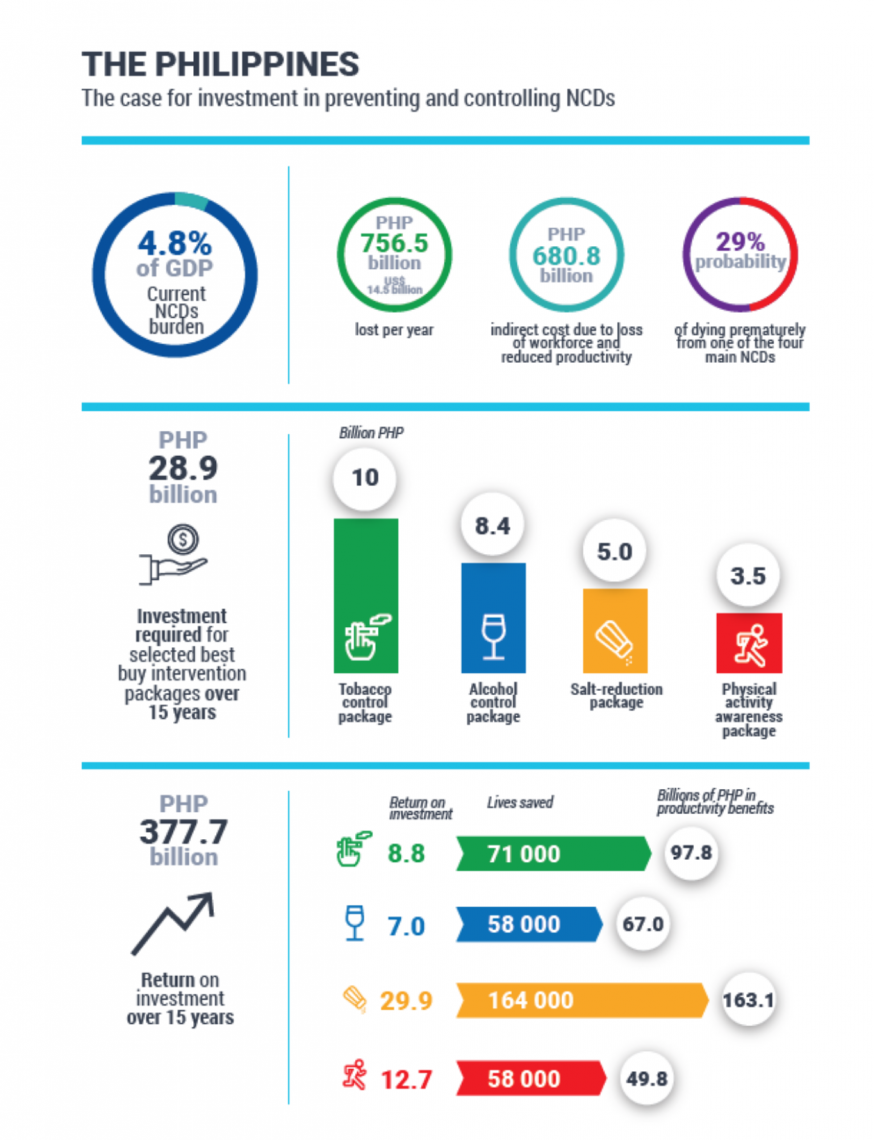
The case for
investment in NCD prevention and control in the Philippines.
Source: WHO, UNDP
The Philippines
needs to redirect its health care strategies in order to combat
non-communicable diseases (NCDs), such as cancer and heart disease,
which account for 68 percent of all deaths in the country and impose
an enormous burden on the economy.
The
economic cost of NCDs to the Philippine economy is P756.5 billion a
year, which is equivalent to 4.8 percent of the country’s annual
gross domestic product, according to a joint study by the World
Health Organization (WHO) and the United Nations Development Program
(UNDP).
Realizing the
economic benefits of investing on measures to combat NCDs among
Filipinos, the Department of Health (DOH) will redirect and
strengthen interventions to prevent and control non-communicable
diseases that cause death to one out of three Filipinos aged 30 to 70
years old.
“This
investment case which we are launching today aims to serve as a guide
in prioritizing and/or redirecting strategies and interventions. We
do not have to reinvent the wheel, so to speak. Rather, we could
capitalize or build on and strengthen what already exists,” Health
Secretary Francisco Duque III said during the launch of the study
Oct. 29.
Cancer, heart
diseases, diabetes, and chronic respiratory diseases are the four
main NCDs in the country. These are caused by a number of risk
factors, with tobacco use, harmful alcohol intake, physical
inactivity, unhealthy diet, and some metabolic risk factors such as
high blood pressure, obesity, and high cholesterol levels topping the
list.
The cost of the
care and treatment of NCDs accounts for 30 percent of the total
government expenditure on health, but more than the direct expenses
in combatting the diseases, it is the indirect cost which causes the
greater economic burden, the study shows.
In 2017, for
example, P75.7 billion was spent by the government on NCD treatment.
However, a resounding P680.8 billion was lost to diabetes and
cardiovascular diseases alone, through the absenteeism, presenteeism
(or being present at work but with reduced productivity), and
premature death (or death before reaching 70 years old) in the
country’s labor force.
High salt
consumption
High salt content
in food products is a major factor in the high rate of NCD cases in
the Philippines.
“This
investment case had been developed in about 20 countries now. Salt
consumption in the Philippines is about two times higher than the WHO
recommended level. WHO recommended level is two grams of sodium per
day, which is about five grams of salt. In the Philippines, it’s
about twelve grams of salt per day,” said Dr. Alexey Kulikov of the
UN Inter-agency Task Force on the Prevention and Control of
Non-communicable Diseases.
Salt content in
food exceeding the recommended level seems to be common among many
countries, he added, pointing out that other countries have started
reformulating recipes of their food, such as bread, to reduce its
sodium content.
Kulikov warned
that this intervention needs to be done gradually, with the
government and private sector working together.
Duque, in a talk
with reporters, said imposing a tax on salty food could curb
excessive salt consumption, a strategy that worked in the case of
taxes levied on so-called six products such as alcohol and cigarette.
Among the
recommended interventions presented in the investment study, the
salt-reduction policy package poses the highest return on investment
(ROI) in the long run. A Philippine peso allotted for this
intervention assures a return of P11.5 in five years, and P29.9 in 15
years. This package includes front-of-pack labelling of food
products, harnessing industry for reformulation of salt content in
food, and salt-reduction strategies in community-based eating spaces.
The tobacco
control package, on the other hand, ranks second in the interventions
with the highest ROI. This includes raising taxes on tobacco,
monitoring of tobacco use among Filipinos, formulation of tobacco-use
prevention policies, emphasizing warning labels in tobacco products,
enforcing restriction of tobacco access among the youth, and putting
a ban on tobacco advertising.
The other
intervention packages in the report are on alcohol control, physical
activity awareness, and clinical intervention. Investing in these
packages would be able to save about 400,000 lives in 15 years, the
report pointed out.
Preventive health
care
Some of these interventions are already being observed in the
country. Taxes on tobacco and liquor, for example, are already
included in the Sin Tax Reform Law. The tax on sweetened beverages,
on the other hand, is covered by the controversial Tax Reform
Acceleration and Inclusion (TRAIN) Law. The government also has set
guidelines on how to properly put front-of-pack labels on prepackaged
food.
In addition, the
DOH foresees the impact of the reforms that the implementation of the
Universal Health Care (UHC) Law would bring the health sector in the
coming years.
“We expect
to have a health system anchored on primary health care shifting
focus from curative to preventive, as well as promotive care,”
Duque said.
The UHC Law, in
one of its provisions, aims to transform the Health Promotion and
Communications Services of the DOH into a Health Promotion Bureau
which would be tasked to promote health literacy among Filipinos, an
aspect deemed important by Health Undersecretary Dr. Myrna Cabotaje.
“So, in the
next year, when we are full blast with our Universal Health Care,
health promotion will be emphasized. And we need to invest also.
Although (expensive) in terms of resources, but when you invest in
health promotion, then we can prevent disease occurrence, and we can
prevent complications of disease,” she said.
The health
promotion bureau will be tasked to fulfil the last recommendation in
the investment report: the establishment of a “national
multisectoral NCD coordination mechanism” which would “strengthen
national coordination and planning for preventing and controlling
NCDs.”
